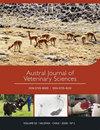Decontamination protocols on bovine fecal and environmental samples for Mycobacterium avium ssp. paratuberculosis growth in solid media
IF 0.8
4区 农林科学
Q3 VETERINARY SCIENCES
引用次数: 0
Abstract
Bacteriological culture of Mycobacterium avium subsp. paratuberculosis (MAP) is considered the gold standard to confirm its presence in several matrices for Johne’s disease diagnosis. Whether it is a liquid or solid culture, a problem with MAP culture is that non-interpretable results arise because of overgrowth by other microorganisms, making MAP growth and identification more difficult or impossible. We systematically reviewed published decontamination protocols and their effects on MAP culture from bovine fecal and environmental samples on solid media. Based on our findings, we suggest a step-by-step decontamination protocol. The OVID®/MEDLINE, PubMed®, SciELO Citation Index®, and Redalyc® platforms as well as the International Colloquium on Paratuberculosis (ICP) proceedings and the reference lists were reviewed to identify relevant studies. The inclusion criteria considered articles published in English, Portuguese, French, German, Spanish, and peer-reviewed journals. The exclusion criteria included unrelated topics, species other than bovines, other than environmental/faecal samples, other than diagnostic techniques of interest, and non-original articles. Definitive studies were obtained through the authors’ consensus regarding their eligibility and quality. In total, 1,004 publications matched the search terms, and 27 articles met the inclusion criteria, of which 45 derived and reported 15 different decontamination protocols. The centrifugation-one-step hexadecylpyridinium chloride protocol, which used over 22,154 fecal samples in three studies, was found to be the most suitable, reporting an average MAP isolation rate of 3.99% (886/22,154) and an average contamination rate of 0.17% (38/22,154). This systematic review highlights the need for further refinement of decontamination protocols to minimize the loss of viable MAP during processing of bovine fecal and environmental samples.牛粪便和环境样本在固体培养基中抑制副结核分枝杆菌生长的净化方案
副结核分枝杆菌(MAP)的细菌学培养被认为是在多种基质中确认其存在以诊断约翰氏病的黄金标准。无论是液体培养还是固体培养,MAP 培养的一个问题是,由于其他微生物的过度生长,MAP 的生长和鉴定变得更加困难或不可能,从而导致结果无法解读。我们系统回顾了已公布的净化方案及其对固体培养基牛粪便和环境样本中 MAP 培养的影响。根据我们的研究结果,我们提出了一个循序渐进的去污方案。我们查阅了 OVID®/MEDLINE、PubMed®、SciELO Citation Index® 和 Redalyc® 平台以及国际副结核病学术会议 (ICP) 论文集和参考文献目录,以确定相关研究。纳入标准考虑了在英文、葡萄牙文、法文、德文、西班牙文和同行评审期刊上发表的文章。排除标准包括不相关的主题、牛以外的物种、环境/粪便样本以外的样本、感兴趣的诊断技术以外的样本以及非原创文章。确定的研究由作者就其资格和质量达成共识。共有 1,004 篇文章符合搜索条件,27 篇文章符合纳入标准,其中 45 篇文章衍生并报告了 15 种不同的净化方案。离心一步法十六烷基氯化吡啶方案在三项研究中使用了超过 22,154 份粪便样本,被认为是最合适的方案,报告的平均 MAP 分离率为 3.99%(886/22,154),平均污染率为 0.17%(38/22,154)。本系统综述强调了进一步完善净化方案的必要性,以最大限度地减少牛粪便和环境样本处理过程中存活的 MAP 的损失。
本文章由计算机程序翻译,如有差异,请以英文原文为准。
求助全文
约1分钟内获得全文
求助全文
来源期刊

Austral Journal of Veterinary Sciences
Veterinary-General Veterinary
CiteScore
1.60
自引率
0.00%
发文量
18
期刊介绍:
Austral Journal of Veterinary Sciences (formerly Archivos de Medicina Veterinaria) publishes original scientific contributions in English, containing the latest developments and discoveries in veterinary sciences. The journal covers topics such as animal health and production, preventive medicine, zoonosis, pharmacology and therapeutics, methods of diagnosis, and other areas related to the veterinary field.
Austral Journal of Veterinary Sciences aims to divulge information about advances in veterinary medicine among universities, research centres, industries, government agencies, biologists, agronomists and veterinarians.
 求助内容:
求助内容: 应助结果提醒方式:
应助结果提醒方式:


